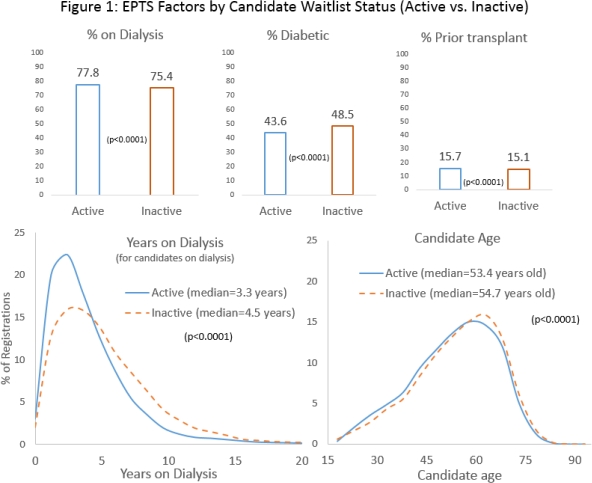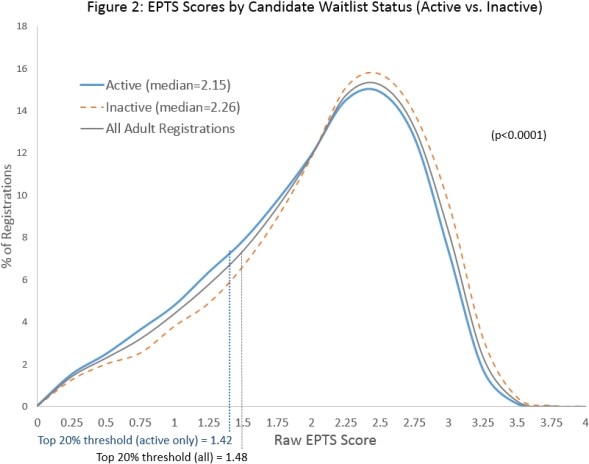Should Only Active Candidates Define the EPTS Top 20% in the New Kidney Allocation System (KAS)?
1UNOS, Richmond, VA
2Univ Hosp Case Med Ctr, Cleveland, OH
3Yale, New Haven, CT.
Meeting: 2015 American Transplant Congress
Abstract number: 89
Keywords: Allocation, Kidney transplantation, Survival
Session Information
Session Name: Concurrent Session: Economics, Policy and Ethics
Session Type: Concurrent Session
Date: Sunday, May 3, 2015
Session Time: 4:00pm-5:30pm
 Presentation Time: 5:12pm-5:24pm
Presentation Time: 5:12pm-5:24pm
Location: Room 118-C
Background: The 20% of kidney candidates with the highest Estimated Post-Transplant Survival (EPTS) receive priority for a high longevity kidney in the Organ Procurement and Transplantation Network's (OPTN) new KAS. The top 20% is based on a snapshot of all adults on the kidney waitlist on a specific date. Both active and inactive adults receive an EPTS score, since at any moment an inactive candidate may be reactivated.
Methods: We used OPTN data to analyze EPTS scores for 60,743 active and 40,054 inactive adult kidney candidates on the waitlist 10/31/14. Lower scores reflect longer expected post-transplant patient survival.
Results: Though inactive candidates less often had a prior transplant (15.1% v 15.7%), they tended to be older (54.7 v 53.4), have longer time on dialysis (4.5 v 3.3 yrs), and were more often diabetic (48.5% v 43.6%) (Fig 1). In turn, the EPTS distribution was higher for inactive patients (Fig 2).
 The top 20% of all adults patients were those with a score less than 1.48 (20th percentile). 22% of active, but only 17% of inactive patients, had scores less than 1.48. When we used only active patients to define the top 20%, the threshold dropped to 1.42. By definition, 20% of active patients qualified, but only 15% of inactive patients did, a net drop of 1,857 patients. With this new threshold, qualifying patients were younger (35.9 v 36.8) and less often diabetic (1.4% v 1.9%); gender, race were similar.
The top 20% of all adults patients were those with a score less than 1.48 (20th percentile). 22% of active, but only 17% of inactive patients, had scores less than 1.48. When we used only active patients to define the top 20%, the threshold dropped to 1.42. By definition, 20% of active patients qualified, but only 15% of inactive patients did, a net drop of 1,857 patients. With this new threshold, qualifying patients were younger (35.9 v 36.8) and less often diabetic (1.4% v 1.9%); gender, race were similar.
Conclusions: Using only active patients to define the top 20% would lead to fewer but slightly healthier candidates receiving priority for high-longevity kidneys. Though this change could lead to slightly improved longevity matching between kidneys and recipients, it would narrow access to the highest quality kidneys and should thus be considered carefully.
To cite this abstract in AMA style:
Stewart D, Kucheryavaya A, Boyle G, Aeder M, Formica R. Should Only Active Candidates Define the EPTS Top 20% in the New Kidney Allocation System (KAS)? [abstract]. Am J Transplant. 2015; 15 (suppl 3). https://atcmeetingabstracts.com/abstract/should-only-active-candidates-define-the-epts-top-20-in-the-new-kidney-allocation-system-kas/. Accessed December 17, 2025.« Back to 2015 American Transplant Congress
